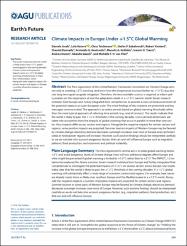Climate impacts in Europe under+1.5 degrees C global warming

Göster/
Tarih
2018Yazar
Jacob, DanielaKotova, Lola
Teichmann, Claas
Sobolowski, Stefan P.
Vautard, Robert
Donnelly, Chantal
Koutroulis, Aristeidis G.
Grillakis, Manolis G.
Tsanis, Ioannis K.
Damm, Andrea
Sakallı, Abdulla
van Vliet, Michelle T. H.
Üst veri
Tüm öğe kaydını gösterKünye
Jacob, D., Kotova, L., Teichmann, C., (...), Sakalli, A., van Vliet, M.T.H. (2018). Climate impacts in Europe under+1.5 degrees C global warming. Earth's Future, 6(2), 264-285. doi: 10.1002/2017EF000710Özet
The Paris Agreement of the United Nations Framework Convention on Climate Change aims not only at avoiding +2 degrees C warming (and even limit the temperature increase further to +1.5 degrees C), but also sets long-term goals to guide mitigation. Therefore, the best available science is required to inform policymakers on the importance of and the adaptation needs in a +1.5 degrees C warmer world. Seven research institutes from Europe and Turkey integrated their competencies to provide a cross-sectoral assessment of the potential impacts at a pan-European scale. The initial findings of this initiative are presented and key messages communicated. The approach is to select periods based on global warming thresholds rather than the more typical approach of selecting time periods (e.g., end of century). The results indicate that the world is likely to pass the +1.5 degrees C threshold in the coming decades. Cross-sectoral dimensions are taken into account to show the impacts of global warming that occur in parallel in more than one sector. Also, impacts differ across sectors and regions. Alongside the negative impacts for certain sectors and regions, some positive impacts are projected. Summer tourism in parts of Western Europe may be favored by climate change; electricity demand decreases outweigh increases over most of Europe and catchment yields in hydropower regions will increase. However, such positive findings should be interpreted carefully as we do not take into account exogenous factors that can and will influence Europe such as migration patterns, food production, and economic and political instability.















